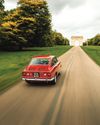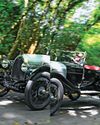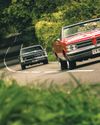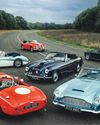
Despite Ferrari's immense competition success during the 1950s and '60s, the Scuderia by no means had a limitless budget at that time. Legendary designer Mauro Forghieri later commented that the company's commitment to evolution rather than revolution was as much a result of financial considerations as engineering principles. Phil Hill, meanwhile, once said that he couldn't remember how much he was paid during his Formula One World Championship-winning season of 1961 - and that, even if he could, he would probably have been too embarrassed to say. In those days, you drove for Ferrari for the glory rather than the money.
Before the arrival of commercial sponsorship in top-level international motorsport, teams had to find other ways to fund their activities. BRM, for example, was backed by the industrial might of Rubery Owen. For Ferrari, it was primarily the sale of road cars that enabled it to go racing, and during the early 1960s, the 250GTE contributed most to that effort. Between 1960 and 1963, 949 GTEs were built, plus five prototypes - a total representing almost 70% of Ferrari road cars at the time.
It wasn't the company's first attempt at a 2+2 - the Touring-bodied 166 coupé that Ferrari displayed at the 1948 Turin motor show had tiny rear seats - but previous efforts had been built in extremely limited numbers. The GTE was the first such Ferrari to go into proper series production, at a time when the concept was still relatively new to the marque. It also spawned a line of front-engined V12 2+2s that would last until the recent GTC4Lusso; the latest Roma continues the theme, but with a twin-turbo V8.
This story is from the August 2022 edition of Classic & Sports Car.
Start your 7-day Magzter GOLD free trial to access thousands of curated premium stories, and 9,000+ magazines and newspapers.
Already a subscriber ? Sign In
This story is from the August 2022 edition of Classic & Sports Car.
Start your 7-day Magzter GOLD free trial to access thousands of curated premium stories, and 9,000+ magazines and newspapers.
Already a subscriber? Sign In

RAY HILLIER
Double-chevron oddity proves a break from the norm for this Crewe specialist

SHORT BACK & GLIDES
Eccentric enthusiast Captain RG McLeod's series of Manx-tailed Bentley Specials reached its zenith with this unique S2 Continental.

People's choice
The diminutive but multi-million-selling Fiat 850 packed a remarkable diversity of form and function into its compact footprint

PLASTIC BREAKS FROM THE NORM
Glassfibre revolutionised niche car-body production, but just occasionally strayed into the mainstream.

A SENSIBLE SUPERCAR
The cleverly conceived four-seater Elite secured Lotus a place at the big players' table, but has it been unfairly maligned since then?

"I had a habit of grabbing second place from the jaws of victory"
From dreams of yachting glory to the Le Mans podium, via a stint at the top of the motorsport tree, Howden Ganley had quite the career

Still going strong
Herbert Engineering staked its reputation on the five-year warranty that came with its cars. A century on, this Two Litre hasn't made a claim

One for the kids
General Motors was aiming squarely at the youth market with the launch of the Pontiac GTO 60 years ago, and its runaway success popularised the muscle-car movement

A NEW BREED OF HERO
Launched at the turn of the millennium, the GT3 badge has already earned a place alongside RS, CS and turbo in Porsche lore.

Brits with SIX appeal
The straight-six engine is synonymous with a decades-long legacy of great British sports cars. Six variations on the sextet theme convene for comparison